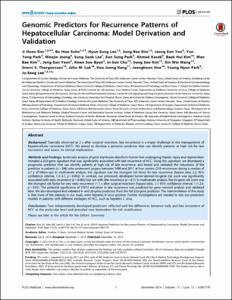Genomic Predictors for Recurrence Patterns of Hepatocellular Carcinoma: Model Derivation and Validation
- Keimyung Author(s)
- Kang, Koo Jeong
- Department
- Dept. of Surgery (외과학)
- Journal Title
- PLOS Medicine
- Issued Date
- 2014
- Volume
- 11
- Issue
- 12
- Abstract
- Background: Typically observed at 2 y after surgical resection, late recurrence is a major challenge in the management of
hepatocellular carcinoma (HCC). We aimed to develop a genomic predictor that can identify patients at high risk for late
recurrence and assess its clinical implications.
Methods and Findings: Systematic analysis of gene expression data fromhuman liver undergoing hepatic injury and regeneration
revealed a 233-gene signature that was significantly associated with late recurrence of HCC. Using this signature, we developed a
prognostic predictor that can identify patients at high risk of late recurrence, and tested and validated the robustness of the
predictor in patients (n=396) who underwent surgery between 1990 and 2011 at four centers (210 recurrences during a median of
3.7 y of follow-up). In multivariate analysis, this signature was the strongest risk factor for late recurrence (hazard ratio, 2.2; 95%
confidence interval, 1.3–3.7; p= 0.002). In contrast, our previously developed tumor-derived 65-gene risk score was significantly
associated with early recurrence (p= 0.005) but not with late recurrence (p =0.7). In multivariate analysis, the 65-gene risk score was
the strongest risk factor for very early recurrence (,1 y after surgical resection) (hazard ratio, 1.7; 95% confidence interval, 1.1–2.6;
p= 0.01). The potential significance of STAT3 activation in late recurrence was predicted by gene network analysis and validated
later. We also developed and validated 4- and 20-gene predictors from the full 233-gene predictor. The main limitation of the study
is that most of the patients in our study were hepatitis B virus–positive. Further investigations are needed to test our prediction
models in patients with different etiologies of HCC, such as hepatitis C virus.
Conclusions: Two independently developed predictors reflected well the differences between early and late recurrence of
HCC at the molecular level and provided new biomarkers for risk stratification.
- Keimyung Author(s)(Kor)
- 강구정
- Publisher
- School of Medicine
- Citation
- Ji Hoon Kim et al. (2014). Genomic Predictors for Recurrence Patterns of Hepatocellular Carcinoma: Model Derivation and Validation. PLOS Medicine, 11(12), e1001770–e1001770. doi: 10.1371/journal.pmed.1001770
- Type
- Article
- ISSN
- 1549-1277
- Appears in Collections:
- 1. School of Medicine (의과대학) > Dept. of Surgery (외과학)
- 파일 목록
-
-
Download
 oak-aaa-04190.pdf
기타 데이터 / 1.17 MB / Adobe PDF
oak-aaa-04190.pdf
기타 데이터 / 1.17 MB / Adobe PDF
-
Items in Repository are protected by copyright, with all rights reserved, unless otherwise indicated.